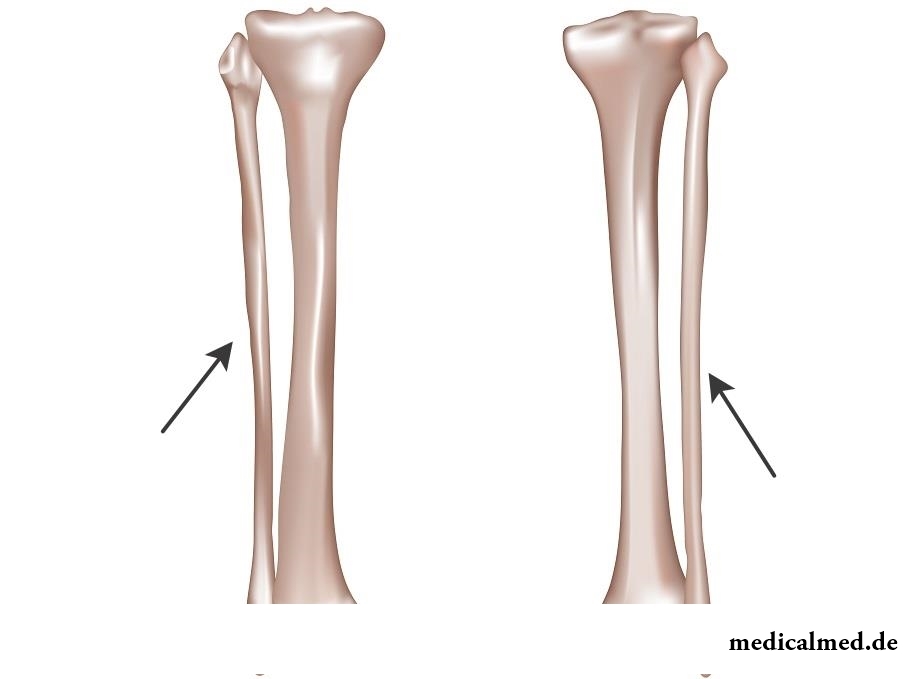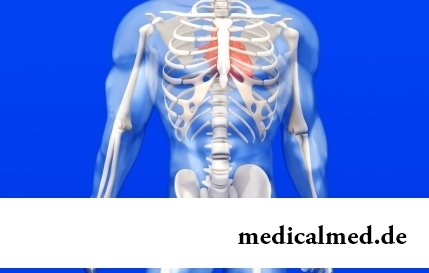





Fibula
Fibula – a tubular, thin and long bone of a shin. It consists of a body and two epiphysis, respectively, upper and lower. The distal or lower end of a bone is an important component of an ankle joint and is called a lateral or outside anklebone. The lateral anklebone is the outside bone stabilizer of an ankle joint.

Structure of fibula
The body of a bone has the prismatic trihedral form, is bent kzad and twisted around a longitudinal axis. The fibular bone has three surfaces: back, lateral, and medial which are divided from each other by three crests.
The first line has the form of an acute crest and separates a lateral surface from medial. The medial crest is located between the medial and back surfaces of a bone, and between lateral and back surfaces the rear edge is located. On a back surface the nutritious opening which lasts in distally the directed nutrient canal is located. On a medial surface it is possible to see interosseous edge.
The upper epiphysis of a fibular bone forms a head which by means of a joint surface connects to a tibial bone. An upper part of a head has the pointed form and is called a head top. From a body the head separates by means of a neck of fibula.
The lower epiphysis of a bone forms a lateral anklebone. Its outside surface is well probed through skin. On the medial surface of a lateral anklebone there is a joint surface by means of which the bone connects to an outside part of an astragalus. A little above on a fibular bone the rough surface which connects to fibular cutting of a tibial bone is located.
On the back surface of an outside anklebone it is possible to see a trace of a sinew of a long fibular muscle – a lodyzhkovy furrow.
Types of fractures of fibula
Changes happen at the different levels of a fibular bone. Preferential, the bone breaks in a lateral anklebone. In turn, the fracture of an outside anklebone of a shin happens at its various levels. As a rule, the fracture of fibula is followed by dislocation or an incomplete dislocation of foot, shortening of a bone and a rupture of a distal interosseous syndesmosis.
Distinguish slanting, splintered, cross, spiral and fragmental fractures of a fibular bone.
Carry to the main symptoms of a change:
- pain at palpation of an outside anklebone;
- hypostasis;
- pain at axial load of a bone; an ankle
- joint pain at the movement.
Treatment of fractures of fibula
Main objective of conservative treatment is comparison and deduction of bone fragments. The traumatologist carries out reposition by means of which the incomplete dislocation of foot and shift of fragments is eliminated. If during reposition of a change reposition passed successfully and a condition of fragments satisfactory, foot and a shin are fixed by means of a plaster bandage or the special orthosis.
If reposition does not yield satisfactory results and the shift of fragments remains, appoint operational treatment of fibula which consists of several stages:
- open reposition of bone fragments is carried out;
- the foot incomplete dislocation is eliminated;
- bone fragments are fixed by means of implants (a pin, screws, a plate).
People who got used to have breakfast regularly have obesity much less often.

There is an opinion that at low temperatures safety of products is ensured longer and better thanks to what the refrigerator considers...
Section: Articles about health
For the last decades the diabetes mellitus of the second type became really world problem. The number of cases annually increases, and average age of patients for whom the illness is diagnosed, steadily decreases. Specialists consider that one of osno...
Section: Articles about health
The dietology, as well as other sciences, does not stand still. Food stuffs are exposed to comprehensive study, and scientists obtain new information on their properties and influence on a human body. Unfortunately, this reasonable and natural process gives unpleasant side effect from time to time: some types of food periodically declare "harmful" or even "deadly" without the bases, sufficient on that....
Section: Articles about health
Producers of milk mixes for children assure: mixes are ideally balanced and adapted for needs of babies. In a sluch...
Section: Articles about health
The state of health of the person in many respects depends on chemical composition of biological liquids of an organism. Specialists consider that PH value of these solutions has to be in range of 7,35-7, 45. A deviation in the smaller party (so-called "acidulation") to a chra...
Section: Articles about health
Urogenital candidiasis (milkwoman) – a fungal infection which annoys unpleasant feelings in the field of generative organs, being followed by white curdled allocations, an itch, discomfort during an urination, pain. She is called by Candida fungus – the opportunistic organism living on mucous membranes of an organism....
Section: Articles about health
All the known slogan "Protect Men!" arose not from scratch. In a sense, the nature created representatives of strong...
Section: Articles about health
Dietary supplements (dietary supplements) for the last decades were so thoroughly included into our life that, apparently, it is already impossible to find the person who at least once did not try them. At the same time, most of our compatriots have a vague idea about...
Section: Articles about health
Herpes simplex of the first type (the infectious disease which is shown periodic bubble rashes on lips is called) – one of the most widespread illnesses. Statistically, only 5% of inhabitants of our planet are unreceptive to its activator, and the reasons of this feature are still not found out. Other people are virus carriers....
Section: Articles about health
For residents of the countries of Southeast Asia various algas are an obligatory component of a daily diet. Their priest...
Section: Articles about health
Many parents of children at the age of 2-4 years face excessively whimsical behavior of the child. The kid exhausts constant crying and whims not only the parents, but also himself. In what the reasons of children's whims. And how to fight with them?...
Section: Slideshow
The naturopathy sometimes moves as the new direction of medicine, something like fashionable hobby, and there is nothing farther from the truth. This most ancient direction, the word "naturopathy" is translated as "treatment by the nature", and, no doubt, treatment by natural gifts was the first and only, available to the person in ancient times. Despite modern achievements of medicine, the naturopathy remains urgent and today, anyway the person - a part of the nature, and природн...
Section: Articles about health
Striya (extension) are the defects of skin having an appearance of direct or wavy strips from 1 to 10 cm long and 1-5 mm wide. In the majority with...
Section: Articles about health
It is impossible to imagine human life in which there would be no plants. Practically in each apartment and any production room there are window plants, millions of people with pleasure are engaged in gardening and truck farming, many citizens пр...
Section: Articles about health
The chia plant, or the Spanish sage, is from South America. The indigenous people of the continent since ancient times used its seeds in food: small, but very nutritious kernels, in a form the reminding fasolina. Indians knew about useful properties of seeds of a chia, and applied them to maintenance of vitality and increase in endurance before serious exercise stresses....
Section: Articles about health
Bees – really unique beings. Practically all products of their life activity are used by the person. Since the most ancient times from...
Section: Articles about health
Ability of an organism to resist to adverse environmental factors (to impact of temperature drops, humidity and pressure, to the attacks of causative organisms, etc.) directly depends on what the person eats. Business here not only in, that C...
Section: Articles about health
The stroke is one of the most widespread diseases of the person, annually in the world about 6 million cases of this pathology are registered. According to medical statistics, strokes occur almost three times more often than myocardial infarctions. The disease belongs to heavy, and has an unfavourable result: the lethality reaches 40% among women and 25% among men. A considerable part of the patients who endured a stroke cannot be recovered completely. We suggest readers to examine...
Section: Articles about health
It is pleasant to state a possibility of improvement of quality of life of people with problems of functioning of secretory system. By efforts that...
Section: Articles about health
Practice of use of table salt in the therapeutic purposes contains not one century. Applications which do by means of the fabric impregnated with saline solution are considered especially effective. They possess antibacterial and antiinflammatory эффек...
Section: Articles about health
"Epilepsy" doctors made the diagnosis in antique times. Displays of an illness and pattern of its development are very well studied. However for nonspecialists this disease remains to not less mysterious, than in the ancient time. Many delusions are connected with epilepsy, and it sometimes very unpleasantly affects quality of life of patients and their relatives. In this article we will try to dispel the most known of similar myths....
Section: Articles about health
Obesity is called by a disease of 21 centuries, for the last 100 years by the number of the people suffering from excess body weight, considerably increased...
Section: Articles about health
(Xerostomia) many people consider feeling of a xerostomia small and easily removable inconvenience. This delusion: the symptom can demonstrate existence of serious diseases. It is worth to remember also that saliva performs important functions...
Section: Articles about health
Tea is loved and use almost everything. This drink has tonic properties, contains the tannins capable to suppress activity of causative organisms. Recently great popularity was gained by teas with vegetable additives. The medicative herbs, spices and fruit which are a part of such mixes enrich drink with vitamins and microelements, increasing its nutritional value and creating additional curative effect....
Section: Articles about health
There is a lot of fans of beer in our country. Statistically, on each average Russian (including women and children) in...
Section: Articles about health
Scientists always aimed to offer fundamental explanations for medical problems. Their theories formed the basis of modern methods of treatment of the hardest pathologies and helped to save a set of lives. However stories are known also such theoretical constructions, following to...
Section: Articles about health
80% of women at least once to lives complained of discomfortable feelings to breasts, consolidations and nagrubaniye. These are mastopathy symptoms. The mastopathy is characterized by change of a ratio between ferruterous and connective tissue tissues of mammary glands. It can lead to formation of cysts (a cystous mastopathy), gland consolidation (a fibrous mastopathy), or a combination of these processes (a fibrous and cystous mastopathy)....
Section: Articles about health
